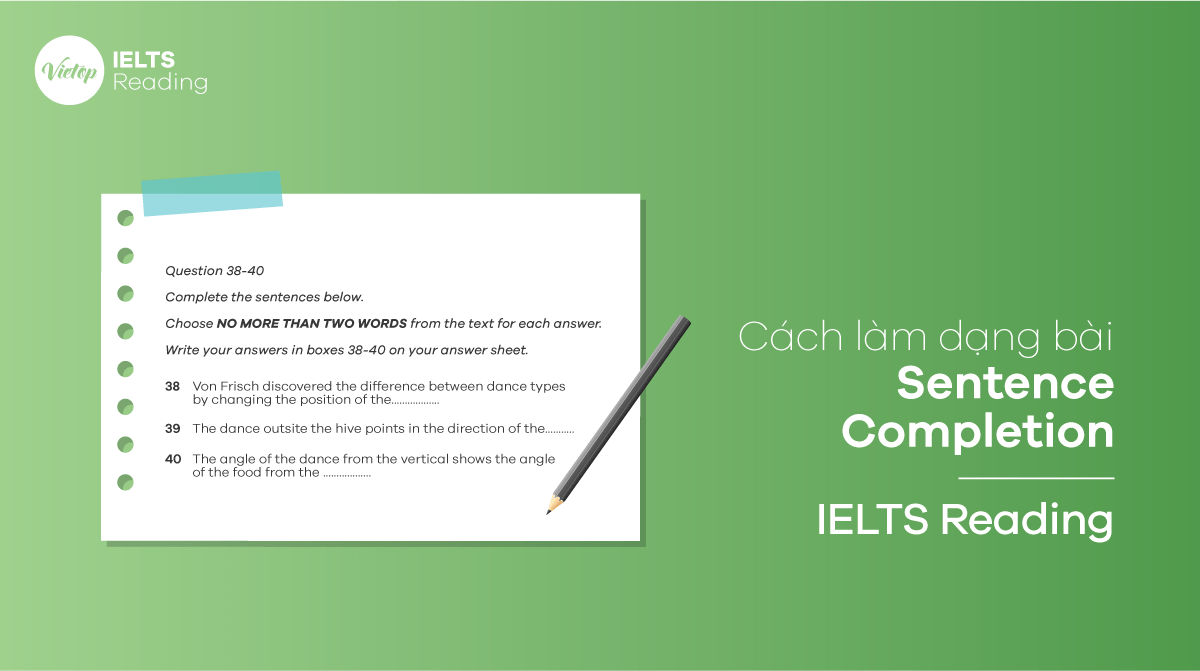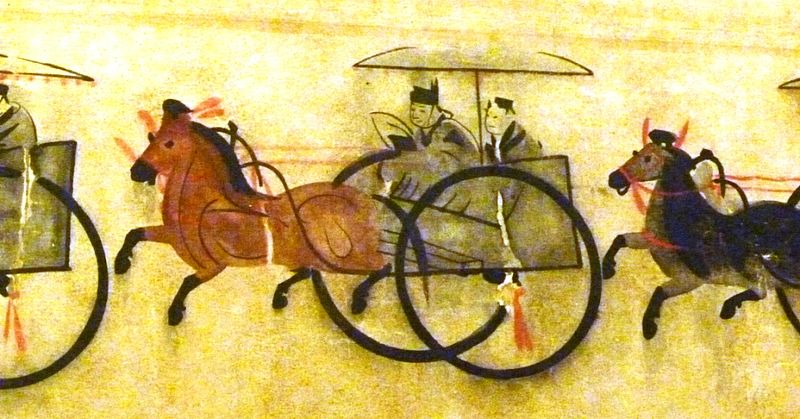Sentence Completion được xem là dạng bài dễ nhất trong các dạng bài của Reading, chính vì vậy mà chúng ta nên cố gắng trả lời đúng càng nhiều câu càng tốt. Trong bài viết hôm nay, IELTS Vietop sẽ cung cấp cho các bạn một số tips, lưu ý và các bước làm bài dạng Sentence completion một cách hiệu quả.
Tổng quan Sentence Completion – IELTS Reading

Trong một phần Reading dạng Sentence Completion, bạn sẽ được cung cấp một số câu có khoảng trống trong đó và được yêu cầu hoàn thành các câu với các từ trong bài viết của tác giả.
Người ra đề đặt câu hỏi bằng cách sử dụng kỹ thuật paraphrase, nghĩa là từ dùng từ ngữ, câu của mình để diễn đạt lại một câu nào đó sao cho nghĩa không đổi.
Ví dụ: Food is very important in our lives (Thức ăn rất quan trọng trong cuộc sống của chúng ta).
-> Câu paraphrase: Food plays a significant role in everyone’s life.
Có nhiều cách để paraphrase, trong đó một cách phổ biến nhất đó là sử dụng từ đồng nghĩa. Đây cũng là cách mà người ra đề IELTS Reading thường hay sử dụng để ra đề. Do đó nếu bạn biết nhiều về từ đồng nghĩa, việc giải đề Reading sẽ rất nhanh và số câu trả lời đúng sẽ cao hơn.
Ngoài ra, sau khi làm mỗi bài tập dạng sentence completion, hãy lập một bảng keyword table để liệt kê các cặp từ được paraphrase trong bài để học và áp dụng cho các bài đọc tiếp theo.
Ví dụ: Đây là 1 bảng keyword của table test 3, passage 3 cuốn Cambridge IELTS 5
Các từ đồng nghĩa thường xuất hiện trong dạng bài Sentence Completion.
| a lot of (nhiều) | plenty of loads of a huge number of multiple numerous |
|
be like (giống như) | resemble similar to |
|
big (lớn, to) |
huge enormous |
|
chance (cơ hội) |
opportunity |
|
change(thay đổi) |
Alter |
| different kinds of…. (nhiều loại ….khác nhau) |
a variety of |
|
enough (đủ) |
sufficient |
|
important (quan trọng) |
significant necessary vital crucial essential |
|
improve (cải thiện) |
enhance better ….. |
|
be known as “…” |
be referred to as “…” called “….” |
|
most (đa số) |
majority |
|
new (mới) |
novel |
|
purpose (mục đích) |
objective aim target |
|
small (nhỏ) |
tiny |

Nhận tư vấn miễn phí khóa học hè
Một số điều cần lưu ý
- Nên đọc câu hỏi trước và đọc bài viết sau.
- Tất cả thông tin đều nằm trong bài văn được đưa, các bạn không dựa vào kiến thức xã hội của mình để trả lời đáp án.
- Nếu đề bài NO MORE THAN TWO WORDS (không quá 2 từ) cho mỗi câu trả lời. Điều này có nghĩa là bạn chỉ có thể viết một hoặc hai từ. Nếu viết từ 3 từ trở lên thì đáp án của bạn chắc chắn sẽ bị sai.
- Các từ được gạch nối, chẳng hạn như well-known, được tính là một từ. Số cũng được tính là một từ. Mạo từ (a, an , the) cũng được tính là 1 từ .Ví dụ: 1000 được tính là 1 từ 2 August được tính là 2 từ
- Khi trong đề bài có xuất hiện cụm từ “…FROM THE PASSAGE” thì các bạn lưu ý đáp án sẽ là từ được lấy ra từ bài đọc và chúng ta không được thay đổi loại từ hay dùng từ đồng nghĩa.
- Các câu trả lời sẽ xuất hiện trong văn bản theo thứ tự giống như các câu hỏi. Câu trả lời cho câu số 1 sẽ ở trên câu số 2 và câu trả lời cho câu số 3 sẽ ở sau câu trả lời cho câu số 2.
- Khi làm bài các bạn hãy xác định kỹ các từ khoá trong câu hỏi, đối chiếu chúng với bài đọc để xác định các từ nào đã được paraphase và loại ra các từ đó.
Các bước làm bài Reading dạng sentence completion

Bước 1: Xác định giới hạn từ được điền
Bước 2: Đọc lướt qua các câu hỏi
- Bước đọc lướt câu hỏi này để nhằm khoanh vùng được đoạn văn nào trong bài chứa thông tin liên quan đến các câu hỏi.
- Trước hết, các bạn chú ý đến các từ viết hoa như địa danh, các từ nằm trong ngoặc nháy “…” hoặc năm tháng, con số bởi các từ này không thể paraphrase và khá dễ tìm.
Bước 3: Đọc câu hỏi, gạch chân keyword và xác định loại từ cần điền
- Chỉ nên gạch chân những từ chứa thông tin như danh từ, động từ, tính từ hoặc trạng từ. Những từ mang nghĩa phủ định cũng nên được gạch chân.
- Còn các từ liên quan đến ngữ pháp như mạo từ, động từ tobe … thì các bạn không cần gạch chân nhé.
Bước 4: Đọc đoạn văn và tìm đáp án
Lưu ý: Các bạn gạch chân keyword ở câu nào thì hãy đi tìm đáp án của câu đó luôn, tránh gạch chân keyword tất cả các câu trong bài rồi sau đó mới làm bài. Việc này rất mất thời gian vì sau đó các bạn vẫn phải đọc lại câu hỏi tiếp theo một lần nữa.
Bước 5: Ghi đáp án, chú ý kiểm tra ngữ pháp và số từ mình điền có phù hợp với yêu cầu không
Tip: Trong trường hợp các bạn đã xác định được đoạn văn mình cần điền nhưng lại không biết nên điền từ gì mới đúng, hãy thử phương loại trừ như sau:
- Trước hết các bạn cần xác định chính xác từ loại mình cần điền vào chỗ trống
- Khoanh tròn những từ trong câu thuộc từ loại đó
- Sau đó các bạn loại ra những danh từ đã được paraphrase trong đề bài, hoặc có thể thay nghĩa của từng từ vào câu hỏi rồi cân nhắc và chọn ra đáp án đúng nhất
Ví dụ:
|
Platypus captivity for research and study purposes requires a …………………… |
|
Only a small number of Australian zoos and universities hold a permit to maintain platypus in captivity for legitimate display or research purposes. |
- Sau khi đọc và phân tích, ta thấy từ cần điền phải là một danh từ vì trước chỗ trống có mạo từ “a”.
- Tìm các từ là danh từ trong câu này, ta có được 5 từ như sau: Zoos, universities, permit, captivity, display , research purposes.
- Ta loaị các từ “captivity”, “Display” và “Research purposes”đã xuất hiện trong câu hỏi, vậy chỉ còn 3 từ là zoos, universities và permit.
- Vì trước chỗ trống cần điền là từ “a”, theo sau nó phải là danh từ số ít -> ta chọn đáp án ở số ít là “permit”.
Xem thêm: Table Completion IELTS Listening
Bài tập thực hành
Bài tập 1:
Ice harvesting required a range of specialist tools, including chisels, ice saws and grapples, and protective equipment, such as special shoes for both the workers and horses. At the beginning of the ice harvest, the surface of the area on a lake selected for harvesting was cleaned of snow, and the ice thickness was tested. This cleaned area was marked out by a worker and a horse pulling a cutter, much like a slim plough, with parallel blades that created long grooves in the lake surface. The ice was then cut along these grooves using metal handsaws. The blocks needed to be manageable for workers lifting and dragging them using the grapples.
The size of individual blocks varied according to their final destination with the smallest being about half a metre square. As about a quarter of the ice could be lost from melting during transport and storage, the further away the destination, the larger the individual blocks needed to be.
In Norway, the artificial lakes for ice harvesting were close to the sea for ease of export. Once the ice blocks were floated to the lake shore, they were lifted out of the water using the grapples and slid along the ice to special slides, which formed a wooden railway carrying the ice down to the docks, where they were loaded onto ships bound for London. Once they reached the London docks, the blocks of ice were unloaded onto horse-drawn barges, and taken along the canal to the underground ice wells in Wharf Road at King’s Cross. There they could be kept for months until they were needed.
As the demand for ice grew, a host of related industries grew up around the ice trade. Apart from the production of the specialist tools and clothing, manuals were printed on how to create artificial lakes for ice harvesting; and special ships and train wagons for delivery of the ice were built among other new developments. The growth of the ice trade also affected the timber industry, as otherwise useless sawdust became a valuable commodity for packing and storing ice during transport.
Questions 1–6
Complete the flow-chart below.
Choose NO MORE THAN TWO WORDS from the passage for each answer
Harvesting the ice
Before the ice was harvested, the 1 ________________ was tested and snow removed from the surface.
⬇
2 ________________ were cut in the ice as markers for the ice cutters.
⬇
The ice blocks varied in size depending on their 3 ________________.
⬇
Between cutting and use approximately a 4 ________________ of the ice could be lost
⬇
Man-made lakes close to the sea
⬇
Ice floated to the 5 ________________
⬇
Sent along 6 ________________ like a rail system to the docks
⬇
Loaded on ships bound for London
Bài tập 2:

Ancient Chinese Chariots
Excavation of ancient Chinese chariots has confirmed the descriptions of them in the earliest texts. Wheels were constructed from a variety of woods: elm provided the hub, rose-wood the spokes and oak the felloes. The hub was drilled through to form an empty space into which the tampering axle was fitted, the whole being covered with leather to retain lubricating oil. Though the number of spokes varied, a wheel by the fourth century BC usually had eighteen to thirty-two of them. Records show how elaborate was the testing of each completed wheel: flotation and weighing were regarded as the best measures of balance, but even the empty spaces in the assembly were checked with millet grains. One outstanding constructional asset of the ancient Chinese wheel was dishing. Dishing refers to the dish-like shape of an advanced wooden wheel, which looks rather like a flat cone. On occasion they chose to strengthen a dished wheel with a pair of struts running from rim to rim on each of the hub. As these extra supports were inserted separately into the felloes, they would have added even greater strength to the wheel. Leather wrapped up the edge of the wheel aimed to retain bronze.
Within a millennium, however, Chinese chariot-makers had developed a vehicle with shafts, the precursor of the true carriage or cart. This design did not make its appearance in Europe until the end of the Roman Empire. Because the shafts curved upwards, and the harness pressed against a horse’s shoulders, not his neck, the shaft chariot was incredibly efficient. The halberd was also part of chariot standard weaponry. This halberd usually measured well over 3 metres in length, which meant that a chariot warrior wielding it sideways could strike down the charioteer in a passing chariot. The speed of chariot which was tested on the sand was quite fast. At speed these passes were very dangerous for the crews of both chariots.
Questions 1-5
Complete the notes below.
Choose ONE WORD from the passage for each answer.
Write your answers in boxes 5-10 on your answer sheet.
1. The hub is made of wood from the tree of 5 …………………
2. The room through the hub was to put tempering axle in which is wrapped up by leather aiming to retain 6 …………………
3. The number of spokes varied from 18 to 7 …………………
4. The shape of wheel resembles a 8 …………………
5. Two 9 …………………was used to strengthen the wheel
6. Leather wrapped up the edge of the wheel aimed to remain 10 ……………
Answer Key
Bài tập 1:
- (ice) thickness
- long grooves
- final destination
- quarter
- lake shore
- special slides
Bài tập 2:
5. elm
6. oil
7. 32
8. dish
9. struts
10. bronze
Trên đây là toàn bộ kiến thức hướng dẫn bạn cách làm bài dạng Sentence Completion – IELTS Reading một cách hiệu quả nhất. Hy vọng nó sẽ giúp ích được cho bạn trong quá trình luyện thi IELTS nhé!
IELTS Vietop












giá mà đề thi IELTS cũng dễ như BT ví dụ =((((